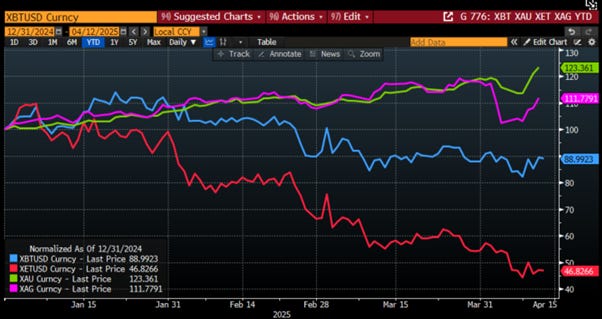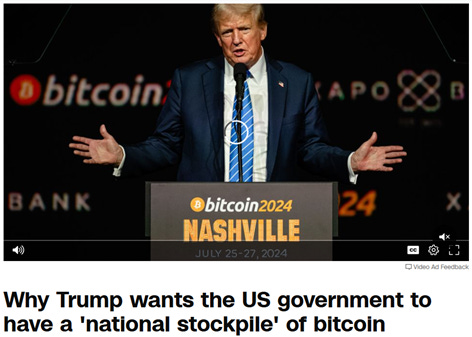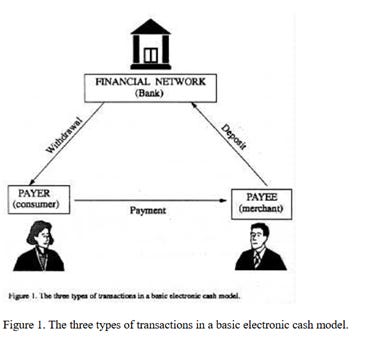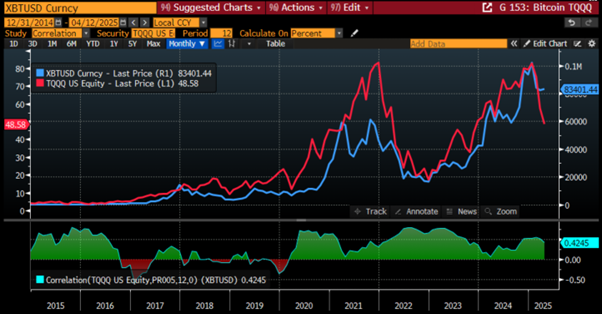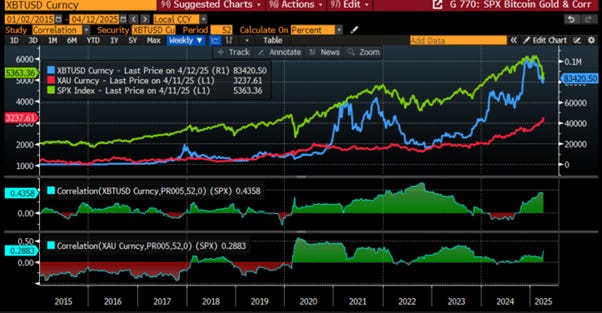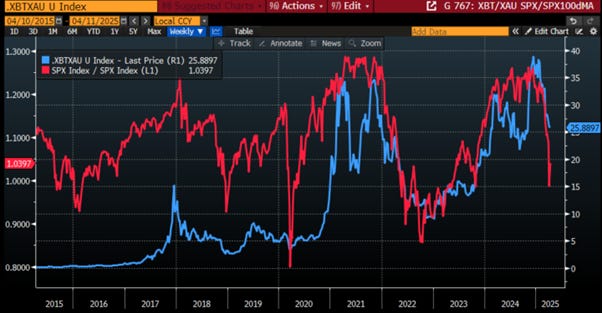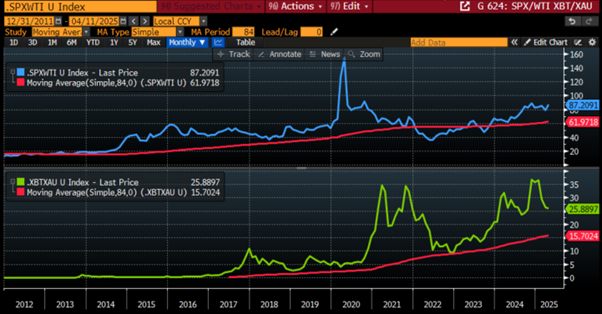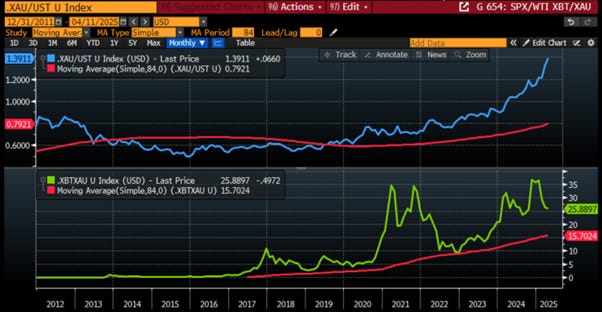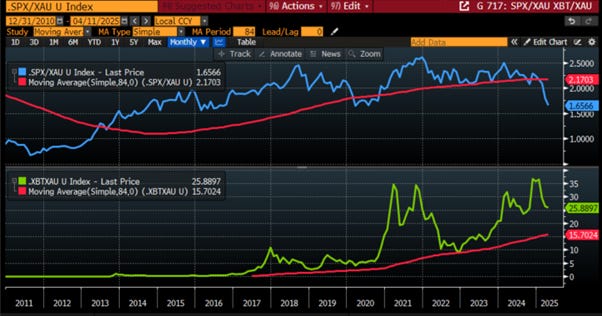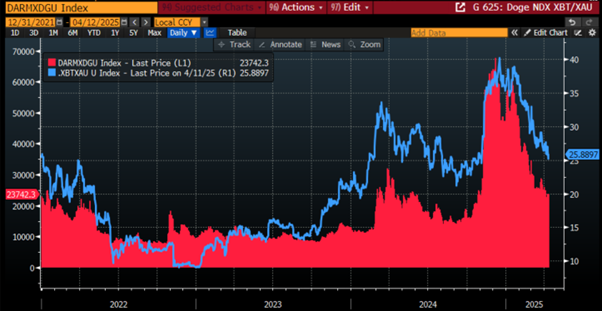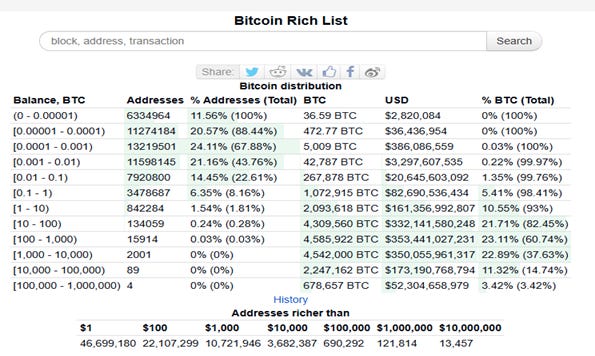When Risk-Off Means Rock-On: Bitcoin Cries, Gold Shines
As the “Forward Confusion” campaign hits full stride under the mandate of the ‘Disruptor In Chief’, one thing’s already crystal clear: Bitcoin is doing a stellar job, at not being a store of value. Despite the breathless hype from some in the new administration touting it as the new gold, or even a future U.S. reserve asset, it promptly peaked the day after inauguration and has been gracefully tumbling ever since. And let’s not forget Ether, lovingly marketed as “digital silver” for the YOLO crowd, it’s down nearly 50% since the start of the Jubilee Year. Meanwhile, actual silver (you know, the shiny grey rock) and that unfashionable “barbaric relic” gold? Quietly posting single- to double-digit gains. So much for the antifragile dreams of digital salvation.
Performance of Bitcoin (blue line); Ether (red line); Gold (green line); Silver (purple line) in USD since December 31st 2024.
When the 47th U.S. president declared ‘Bitcoin is the new oil’ during his campaign, outside the political purpose of this statement, those familiar with the 1970s saw echoes of history. Back then, oil prices were deliberately inflated to prop up the dollar and ease America’s post-Vietnam debt burden, creating a bubble that benefited the U.S. at the expense of the rest of the energy-dependent world.
https://edition.cnn.com/2024/08/01/politics/video/trump-crypto-national-bitcoin-stockpile-digvid
Bitcoin may well be playing the same role oil did in the 1970s, deliberately inflated to relieve unsustainable U.S. debt. Back then, oil was weaponized to prop up the petrodollar. Today, Bitcoin looks like the new bubble, ripe for speculation, designed to absorb debt pressure, and enriching a well-positioned few. But what if Bitcoin was never the anti-establishment, decentralized savior it claimed to be? What if it was rolled out as a clever Trojan horse—sold as a rebellion against central banks, only to become their tool? Imagine BTC as the gateway drug, luring capital into UST-backed stablecoins like Tether, effectively CBDCs under a different label, designed to offload U.S. debt to retail and institutional speculators.
https://groups.csail.mit.edu/mac/classes/6.805/articles/money/nsamint/nsamint.htm
The dots connect disturbingly well. Inflate BTC, create speculative demand, tie it to UST-backed tokens, and let the public, not the FED, monetize the government’s fiscal sins. In this light, Bitcoin investors aren’t de-centralized heroes. They’re part of the machine, knowingly or not. The ultimate irony is that this ‘decentralized revolution’ could be the most politically centralized trade in modern history, and it's rocketing higher. Even Larry Fink, once a BTC skeptic, is now cheering it on while the biggest swindler in wall street history (i.e. Micheal Saylor) is now advising the US president to sell the US gold stored at Fort Knox to buy the biggest meme scam that has ever been created in financial history.
Rather than listening to the mesmerizing propaganda around Bitcoin and other crypocurrencies, savvy investors know that, despite the hype, Bitcoin has spent most of its short life moving in lockstep with risky assets. Case in point: its strong positive correlation, often above 0.5, with TQQQ, the ETF designed to triple the daily performance of the Nasdaq 100. It’s been a high-stakes dance between two speculative darlings, rising and falling together in perfect speculative harmony.
Price of Bitcoin in USD (blue line); Price of ProShares UltraPro QQQ Index (TQQQ US) (red line) & correlation.
Since their respective all-time highs, the S&P 500 has corrected by 13%, and Bitcoin by almost 21%, yet gold continues to make new all-time highs, which could point to what really matters. The US stock market’s record-breaking run since the financial crisis may be comparable to decades of surging US trade deficits that attracted export-dependent economies. Rising beta has lifted all boats, but the lesson from Q1 is that the tide might be starting to ebb. If the S&P 500 drops another 10%, it could approach the Q1 2022 peak of around 4,800. As for Bitcoin? That similar level for the crypto is just under $48,000, an additional 40% downside from its current level . What’s interesting here is that Bitcoin’s 52-week correlation to beta (S&P 500 Index) is increasing, while gold’s correlation to beta has been decreasing since late 2024.
Bitcoin Price (blue line); Gold Price (red line); S&P 500 Index (green line) & Correlation.
The Bitcoin-to-gold ratio, which bottomed below 3x in 2019, is still sitting at nearly 26x today. What’s preventing it from reverting lower? The answer may lie in the broader market dynamics. The S&P 500 is pulling back from a rare 25% premium to its 100-week moving average. It took the pandemic-induced crash of 2020 and the biggest money pump in history to reach this stretched level in 2021, the first time since 1999. This could signal potential for risk assets to revert, with cryptos being among the riskiest. If beta is destined to return to its mean, the same could apply to the Bitcoin/gold ratio. Historically, the 10x level has acted as a pivot since 2017. US deficit spending has fuelled speculation and inflated equity markets and risk assets, but with unprecedented austerity and tariffs ahead, the stage could be set for a reversion.
Bitcoin to Gold Ratio (blue line); Ratio of the S&P 500 Index to S&P 500 Index 100 day Moving Average (red line).
Ultimately, savvy investors know that the real DOGE is neither a phantasmagorical cryptocurrency nor a propagandistic acronym used by the ‘Disruptor in Chief’ to spread additional forward illusions and confusion among investors. What truly matters is the state of the business cycle, which can be proxied by market-driven data such as the position of the S&P 500-to-Oil ratio and the Gold-to-Bond ratio against their respective 7-year moving averages. Looking at the evolution of the Bitcoin-to-Gold ratio against its 7-year moving average, and the S&P 500-to-Oil ratio against its 7-year moving average, nobody needs a PhD in finance or a job on Wall Street to understand that the times when the Bitcoin-to-Gold ratio peaks have coincided with peaks in the S&P 500-to-Oil ratio. These peaks have usually preceded the break of the S&P 500-to-Oil ratio below its 7-year moving average by only a few months, as was the case in early 2020 and late 2021.
Upper Panel: S&P 500 to Oil Ratio (blue line); 7-year Moving Average of the S&P 500 to oil ratio (red line); Lower Panel: Bitcoin to Gold ratio (green line); 7-year Moving Average of Bitcoin to Gold Ratio (red line).
Looking at how the Bitcoin-to-Gold ratio interacts with other market-driven ratios, like the Gold-to-Bond ratio, there has been no noticeable trend that investors can use to anticipate a shift between an inflationary and a deflationary environment over the past 10 years of market data available for the cryptocurrency.
Upper Panel: Gold to Bond ratio (blue line); 7-year Moving Average of the Gold to Bond ratio (red line); Lower Panel: Bitcoin to Gold ratio (green line); 7-year Moving Average of Bitcoin to Gold Ratio (red line).
Ultimately, savvy investors who have thoroughly studied the changes in the business cycle throughout history know that the market-driven indicator that can serve as a canary in the financial coal mine to anticipate shifts in the S&P 500-to-Oil ratio is the S&P 500-to-Gold ratio; better known as the indicator of monetary illusion. Interestingly, much like the S&P 500-to-Oil ratio, peaks and troughs in the S&P 500-to-Gold ratio and its break below the 7-year moving average correspond with peaks and troughs in the Bitcoin-to-Gold ratio, as was the case in March 2020, and more recently in October 2021 and January 2025.
Upper Panel: S&P 500 to Gold ratio (blue line); 7-year Moving Average of the S&P 500 to Gold ratio (red line); Lower Panel: Bitcoin to Gold ratio (green line); 7-year Moving Average of Bitcoin to Gold Ratio (red line).
To nail the demonstration that Bitcoin is at best just a speculative tool created to satisfy the speculative greed of YOLO investors, the fact that the Bitcoin-to-Gold ratio is trading almost tick-for-tick with Dogecoin’s market cap should be the ultimate argument for savvy investors to stay away from this crypto money-laundering tool and focus exclusively on gold as the only antifragile asset with no counterparty risk.
Bitcoin to Gold Ratio (blue line); DogeCoin Market Cap (red historgram).
In a few words, many investors may have fallen into the political trap set by the ‘Disruptor In Chief’ who is also the ‘Manipulator In Chief’, who made Bitcoin partisan, presenting it as a magical asset for YOLO investors who buy into fairy tale stories. In a world on the brink of a 'Money AIst', the truth is that the largest financial theft ever isn’t just tied to AI hype, but also to the belief that Bitcoin and other cryptocurrencies are antifragile assets. The reality is that Bitcoin is just another speculative tool, bound to melt down along with the AI bubble. This means most YOLO investors holding the 'Malificent 7' and Bitcoin, expecting a new normal, are about to face a market-driven wealth transfer.
Savvy investors understand that gold is rising not because it's flashy, but because fiat currencies are spiraling deeper into debt, a reality even our Bitcoin fans acknowledge. Like the central banks of the East and the ascending BRICS+ nations, savvy investors recognize that gold, not Bitcoin, is the preferred trade-settlement asset in a world turning away from weaponized US dollars and US Treasuries. Even the BIS, for all its centralization, acknowledges gold as the only other Tier-1 asset alongside the “return-free-risk” of the once-revered US 10Y Treasury. The implications of gold’s Tier-1 status are profound: unlike Bitcoin, gold truly is a store of value.
https://stonexbullion.com/en/blog/basel-iii-and-the-gold-market/
For those like Michael Saylor who still preach that Bitcoin will topple the USD as the world’s reserve currency and replace gold as the ultimate antifragile asset, it's time to separate hype from reality. Bitcoin is a speculative trading vehicle, not a currency, nor a store of value. That may upset overnight Bitcoin millionaires or hopefuls, but truth isn’t a popularity contest. The mystery around its creator, Satoshi Nakamoto—missing since 2011 with 1 million untouched BTC (over $80 billion today)—raises serious questions. First, the name Satoshi Nakamoto, when written in Japanese, can carry multiple meanings depending on the kanji used. Satoshi (哲史) can mean “wise” or “philosopher,” while Nakamoto (中本) suggests “central origin” or “middle foundation.” This translation already add a layer of mystery to Bitcoin’s origins. Second, one wallet holds 5% of all mined Bitcoin. Will it stay untouched forever? Believing a lone genius outsmarted every government and created the perfect anti-establishment tool is naive. In truth, Bitcoin is a bureaucrat’s dream—fully traceable and programmable. It’s not financial freedom. It’s financial surveillance.
https://bitinfocharts.com/top-100-richest-bitcoin-addresses.html
Read more and discover how to trade it here: https://themacrobutler.substack.com/p/when-risk-off-means-rock-on-bitco…
If this research has inspired you to invest in gold and silver, consider GoldSilver.com to buy your physical gold:
https://goldsilver.com/?aff=TMB

Disclaimer
The content provided in this newsletter is for general information purposes only. No information, materials, services, and other content provided in this post constitute solicitation, recommendation, endorsement or any financial, investment, or other advice.
Seek independent professional consultation in the form of legal, financial, and fiscal advice before making any investment decisions.
Always perform your own due diligence.
NEVER MISS THE NEWS THAT MATTERS MOST
ZEROHEDGE DIRECTLY TO YOUR INBOX
Receive a daily recap featuring a curated list of must-read stories.
Trending on ZeroHedge

8 Habits That Can Add Decades To Life

Justin Trudeau Getting Two Pensions And Severance Worth Over $8 Million




 Latest: Epstein Deep Dive
Latest: Epstein Deep Dive